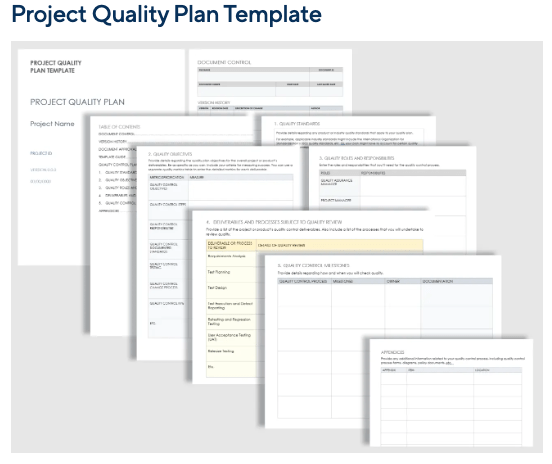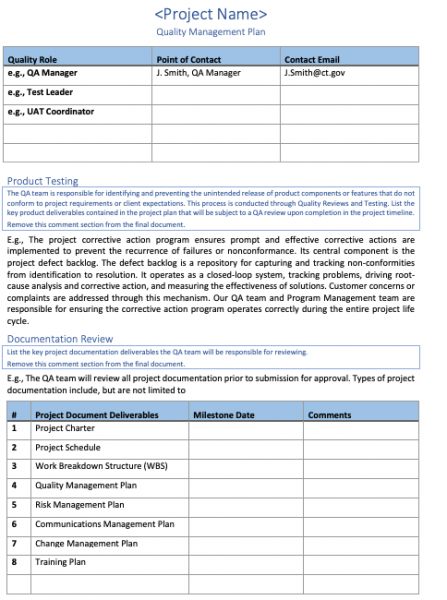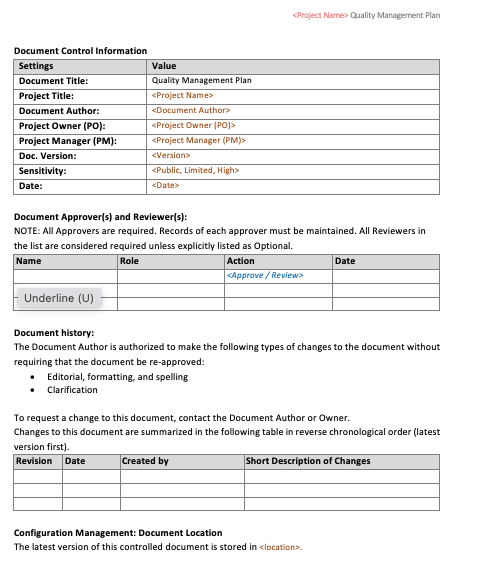A quality management plan template is a document that outlines the processes and procedures that will be followed in order to ensure the quality of a project. It is an important tool for project managers, as it helps to ensure that all aspects of the project are taken into consideration and that risks are minimized.
This document should be created at the beginning of the project and should be reviewed and updated on a regular basis as the project evolves. It also includes analyzing the project for quality problems, developing and implementing solutions to fix those problems, and monitoring the results of the solutions for the outcome of the project.
Quality in project management is a process that includes the configuration, development, and implementation of quality standards within a project. Quality standards are set by an organization or a team to ensure that the project meets all requirements and deliverables and that it is free of any defects or errors.
A quality management plan is a formal document that outlines an organization’s strategy for ensuring that its deliveries meet the quality standards that have been set. The plan is created by the project manager in consultation with the project team and stakeholders. It is then used as a guide throughout the project to ensure that quality is maintained.
The quality management plan should cover all aspects of quality, from planning and design to execution and delivery.
In general, it should include a description of the organization’s quality policy, objectives, procedures, and processes.
It is important to note that the quality management plan is not a static document; it should be reviewed and updated on a regular basis to ensure that it remains relevant and accurate.
If you are planning on taking the PMP exam, then it is essential that you have a good understanding of quality management plans.
Quality Management Plan Template Word
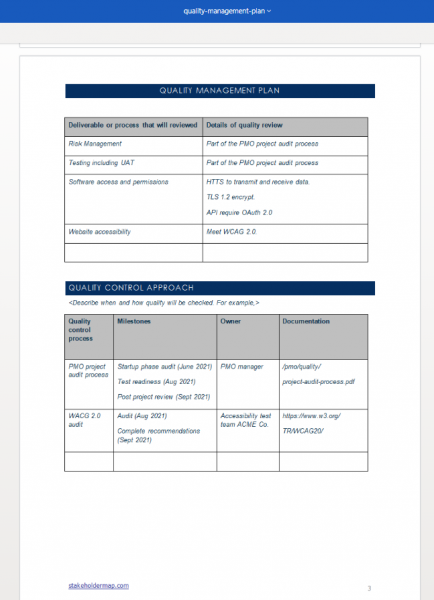
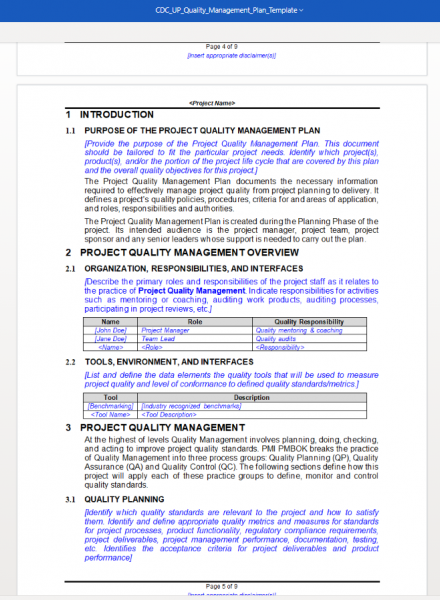
Importance of quality management in project management
It is important for organizations to have a quality management plan in place in order to ensure that their products and services meet customer expectations.
By having a quality management plan, organizations can also avoid potential problems and save money in the long run.
This can massively improve its overall performance while consistently giving high-quality deliverables that are directly related to customer satisfaction and loyalty. It can also help to reduce costs by identifying and eliminating sources of defects and waste.
A well-developed quality management plan can also help to improve communication and collaboration within a company, as well as promote a culture of continuous improvement.
It can also help to reduce costs by identifying and eliminating sources of defects and waste. For example, a company is more likely to produce sub-par products and services that do not meet the needs of its customers.
If you are planning to implement a quality management system, then a quality management plan is an essential tool that will help you to achieve your quality objectives.
Quality Management Template Excel
Who Is Involved In Creating a Quality Management Plan?
There are a few key players involved in creating a quality management plan.
Upper management is responsible for setting the overall direction for the company and for ensuring that the quality management plan is consistent with the company’s goals and objectives. The first is the project manager, who is responsible for ensuring that the project meets all quality requirements.
The second is the quality assurance team, who is responsible for testing the product or service to make sure it meets all quality standards. They are responsible for developing and implementing the quality management plan.
They are also responsible for monitoring the effectiveness of the plan and making necessary changes.
Finally, Other key personnel, such as quality control inspectors, are responsible for ensuring that the products and services meet the quality standards set by the company.
All of these teams must work together to create a quality management plan that meets the needs of the project.
What Is The Role Of The Project Manager In This Process?
The project manager plays a critical role in this process, as they are responsible for ensuring that all stakeholders understand and agree to the QMP.
They will also need to monitor the progress of the QMP and make adjustments as needed.
The project manager should also be familiar with the various quality tools and techniques that can be used to measure and improve quality.
PMs have the big responsibility to assign roles and responsibilities to team members in order to ensure that the plan is executed effectively.
When creating a document, PMs must establish the:
- Objectives
- Policies
- Process
Mainly everything regards the organization’s quality.
The project manager plays a critical role in this process, as they are responsible for ensuring that all stakeholders understand and agree to the Plan. They will also need to monitor the progress of the QMP and make adjustments as needed.
The project manager plays a critical role in this process, as they are responsible for ensuring that all stakeholders understand and agree to the Plan. They will also need to monitor the progress of the QMP and make adjustments as needed.
Components Of Quality Management Plan
Any quality management plan must have several key understandings between team members and everyone involved in order to be effective.
This includes clarity in quality policy, quality objectives, quality standards, and quality procedures.
Let’s take a closer look at each of these components.
- A quality policy is a statement from management that outlines the overall approach to quality management for an organization. The quality policy should be reviewed and updated regularly to ensure it remains relevant and accurate.
- Quality objectives are specific goals that an organization sets to improve its quality management system. Quality objectives should be measurable and relevant to the organization’s business.
- Quality standards are the specific requirements that an organization must meet in order to achieve its quality objectives. Quality standards can be internal or external.
- Internal quality standards are typically developed by the organization itself, while external quality standards are usually set by an external department.
As we mentioned, here we start to develop deeper the four essential components of a quality management plan
- Quality policies
- Quality objectives
- Quality standards
- Quality improvement
Each of these components is necessary to ensure that the quality management plan is comprehensive and effective. Let’s take a closer look at each one.
Quality Policy
The quality policy is the overall statement of what the organization wants to achieve in terms of quality. It should be developed with input from all stakeholders and be approved by senior management. The quality policy should be reviewed and updated regularly to ensure it remains relevant and accurate.
Quality Objectives
Quality objectives are specific, measurable goals that the organization wants to achieve in order to meet its quality policy. They should be developed for all relevant functions and levels within the organization. Quality objectives should be measurable and relevant to the organization’s business.
Quality Standards
Quality standards are the guidelines that will be used to assess whether the organization is meeting its goals.
Quality improvement
This includes analyzing the project for quality problems, developing and implementing solutions to fix those problems, and monitoring the results of the solutions.
Phases of Project Quality
For any project to be successful, quality must be built into it from the start. This requires a commitment from everyone involved in the project, from the project manager to the individual contributors. Quality must be planned for, assured, and controlled throughout the project.
There are three main phases of project quality: quality planning, quality assurance, and quality control. Each of these phases has its own activities and deliverables.
Quality planning
In quality planning, the project manager develops a quality plan that outlines the quality objectives, policies, and procedures for the project. Basically, the process of deciding what quality standards will be used and how they will be met.
Quality assurance
Quality assurance is the process of ensuring that the project meets the quality standards set in the quality plan. This is done through audits, reviews, and testing.
Quality control
Quality control is the process of monitoring and measuring the project to identify any variance, problems, or deviations from the quality standards and take corrective actions.
All three of these phases are important in ensuring that the project meets the required quality standards. Quality must be considered at every stage of the project, from planning to execution to delivery. By following these steps, you can be sure that your project will be successful.
Quality Management Plan Template PDF
The Structure Of The Living Document
A quality management template is a type of document that provides a suggested structure for creating a quality management plan. The template can be used as-is or adapted to suit the needs of your specific organization.
First, you need to identify the customer’s requirements. These can be gathered through market research, customer surveys, or other methods. Once you have a good understanding of the customer’s needs, you can start developing the processes and policies that will be used to meet those needs. When creating a quality management template, it is important to include the following sections:
Introduction
This section should provide an overview of the quality management plan and its purpose.
Scope
This section should describe the scope of the quality management plan, including which processes and products will be covered.
Roles and Responsibilities:
This section should assign roles and responsibilities for ensuring quality throughout the organization.
Standards
This section should list the standards that will be used to measure quality, specifically the requirements you were required to meet with your client and stakeholders. All the information can count.
Metrics
This section should define the metrics that will be used to track progress and give total insight into what is going to happen. This is important because here is where your stakeholders will see how the roadmap of schedule and budget will bring results.
To sum up, the components should have
- The objectives of the project
- The policies and procedures that will be used to manage quality
- The risks that could impact the quality of the project
- The roles and responsibilities of all stakeholders in the project
- The schedule for quality assurance and quality control activities
- The budget for quality assurance and quality control activities
If you follow these steps, you will be well on your way to creating a quality management template that will help your business to improve its quality management procedures.
Consequences Of Not Having a Quality Management Plan
There are a number of consequences that can result from not having a quality management plan in place.
- One of the most serious consequences is that it can lead to subpar products or services being delivered to customers. This can damage your company’s reputation and lead to a loss of business.
- Another consequence is that it can lead to increased costs as you scramble to fix errors and rework products or services.
- Not having a quality management plan can also lead to employees feeling stressed and overwhelmed as they try to meet quality standards. This can lead to a high turnover rate and a decrease in employee morale.
- Finally, not having a quality management plan can also impact your bottom line. By not having a plan in place to ensure quality, you may end up spending more on rework, refunds, and other expenses.
In the end, not having a quality management plan can have a ripple effect that impacts every area of your business.
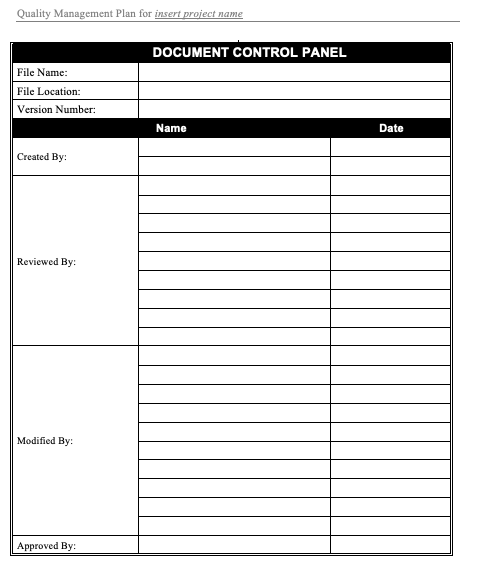
Why use a Quality Management Plan Template
There are many benefits to using a quality management plan in project management.
Perhaps the most obvious benefit is that it helps ensure that the final product meets the specific quality requirements set forth by the client or customer
It also provides a framework for monitoring and mitigating risks to quality.
The main benefits of using a Quality Management plan are:
- Ensures that the project meets all relevant quality standards
- Helps to identify and mitigate risks to quality
- Provides a framework for monitoring quality throughout the project
- Guides decision-making around quality issues
- Helps to ensure customer satisfaction
If you are planning a project, you should consider creating a QMP to help ensure that the quality of your project meets the required standards.
Tools in quality management
There are a variety of tools available to project managers that can be used to improve quality management. Three of the most popular tools are:
- Sampling
- Root cause analysis
- Fishbone analysis.
- Sampling is the process of selecting a representative group from a larger population. This can be used to test products or processes to ensure that they meet quality standards.
It involves taking a small sample of the product or process and testing it for various quality parameters.
- Root cause analysis is a tool that is used to identify the underlying cause of a problem. This is often used in conjunction with fishbone analysis (also called cause and effect diagrams). This is done by identifying all the factors that could have contributed to the problem and then eliminating the factors one by one until the root cause is isolated.
- Fishbone analysis also known as the cause and effect diagram is a tool that is used to visualize the potential causes of a problem. It is often used in conjunction with root cause analysis to help identify the root cause of a problem.
What is a Quality Management Plan?
A quality management plan is a written document that outlines the quality standards for a project and the procedures for ensuring that those standards are met. A quality management plan is a document that outlines the processes and procedures that will be followed in order to ensure the quality of a product or service. It includes the quality standards that will be used, the resources that will be required, and the roles and responsibilities of the team members.
The quality management plan should be reviewed and updated on a regular basis to ensure that it remains relevant and effective. Additionally, it should be reviewed whenever there are changes to the product or service, the team, or the process. By having a quality management plan in place, you can be sure that your product or service will meet the highest standards.
What is the main role of the Project Manager when creating a Quality Management Plan?
When creating a Quality Management Plan, the role of the Project Manager is to establish the objectives, policies, and processes of the organization with regard to quality. They will also ensure that all members of the team are aware of the Quality Management Plan and its objectives. Furthermore, the Project Manager will monitor the progress of the project to ensure that quality standards are being met. A project manager plays a vital role in quality management, as they are responsible for developing and implementing quality control plans, as well as ensuring that all team members are trained in quality assurance techniques.
There are various ways in which a project manager can ensure that the project meets the required standards of quality. They can develop quality assurance plans, set up quality control measures, and carry out regular audits. By doing so, they can ensure that the project is completed to the required standards and that any problems are identified and rectified before it is too late. The project manager also ensures that quality audits are conducted on a regular basis and that corrective action is taken when necessary. By ensuring that the project meets all quality standards, the project manager can help the company save money and avoid potential legal problems.
Why is Quality Management Plan important for Project Managers and Organizations?
This document can help improve the efficiency of the project team by identifying and addressing potential areas of improvement. Also, it can help keep the project within budget by identifying and managing potential cost overruns.
What are the main consequences of not having a Quality Management Plan?
You may find it difficult to meet customer expectations if you don’t have a plan in place to ensure that your products or services are of the highest quality. This can lead to dissatisfied customers and a loss of business.


